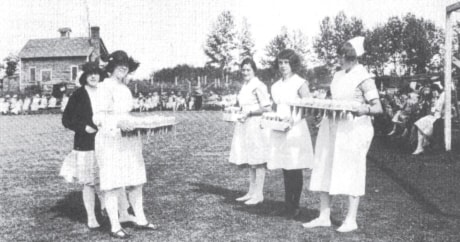One basic necessity for a sound and healthy mind, or to help restore a mind in need of psychiatric treatment, is some form of daily recreation to help relieve physical and mental tensions.
Recreational therapy has been traditionally recognized as a vital and carefully organized part of the ongoing daily treatment programs at the Centennial Centre for Mental Health and Brain Injury for many decades.
Since the opening of the Provincial Mental Hospital near Ponoka in 1911, the high quality of care and treatment for the patients has also included as much exercise and physical activities as possible. Early beginnings would feature the showing of black and white movies, bringing entertainment groups into the hospital, and encouraging, exercise, brisk walks and games. A more extensive program began in the late 1940s with the completion of the recreation hall, which had a big stage, could seat over 400 guests for events, and was a fully equipped gym and social activity centre.
With the blessings and co-operation of the administration, medical, nursing, and support staff at the facility, new recreation staff members William Savage, Michael Rainone Sr., and Millie Holman were encouraged to devote the major part of their time helping to organize various activities for the close to 1,400 patients. These weekly activity events during the day and evenings would include everything that the patients might be interested in, including social gatherings, music, movies, dances, sports, theatrical productions, parades, fashion shows, church services, teas and an ample supply of reading materials and games.
The careful monitoring of these ongoing recreational activities soon revealed that they had become potent and valuable instruments in arousing the interests of the patients, as well as stimulating socially adaptive behaviour. This treatment was also working to awaken spontaneous and enthusiastic responses, as well assisting the wellness and re-education of the patients, and encouraging them to enjoy participation and co-operation with others. The goals of the varied hospital-wide recreation programs not only included participation by as many in-patients as possible, but also would hopefully help them in the long term to prepare for life outside the facility after discharge.
A two-fold recreations program was developed
As the recreation therapy program progressed, there would be wide and varied differences as to how and to whom the activities were to be administered. These would be carefully planned and formed into two categories that were eventually able to carry on every day at the busy psychiatric hospital, often side by side. The first was to establish a recreation program for amusement and fun, with the chief objective being the diversion of the patients, while the second was geared more particularly to the specific needs of the individual. The latter included weekly meetings and reviews with the treatment teams, with emphasis on diagnosis, physical condition and suggested activities for each personal case.
Along the way, special groups were formed to include more intense therapy for patients. These might include ballroom dancing, square dance classes, dramatics, glee club and choir, a hospital band, literary and reading groups, physical training, and others. Visits to other areas around the hospital such as the powerhouse, shoe shop, tinsmith, etc. were arranged, which could possibly later encourage some form of employment. Over the years the culmination of all these recreation and social activities would encourage present and new patients at the Provincial Mental Hospital to feel welcome as a necessary part of the ongoing treatment program.
Participants would also benefit from the companionship, as well as gaining new interests and self confidence from taking part in an activity, whether it be on the wards, at the recreation hall or out on the spacious grounds. With the introduction of television, 85 per cent of the wards were equipped with a set, as well as a piano, radios and record players, and easy access to all types of popular books and records. Special additions to the program over the years were the establishment of the peaceful Lake Eden Camp and activities area near Chain Lakes, as well as bus or van trips to various events in and around the community and throughout the province.
Outside recreation and social activities included special areas and fields for all individual and team sports, including a two sheet-curling rink, outdoor skating rink, and access to the nine-hole Ponoka Community Golf Course. As well as participating, the patients were always encouraged to help plan and set up the many year round recreation/social activities, as well as being a part of the ward associations and sports council, and the publication of the monthly hospital magazine.
Over the years, the recreational therapy program has continued to grow and be extremely successful, with thousands of patients and staff taking part and enjoying the countless sports and social activities. In keeping up with ever-changing methods of psychiatric treatment and care, extensive modernization additions and renovations have occurred over the past 25 years at the Centennial Centre. The very busy team of recreation therapists at the hospital have also extended their programs into the community, and a report on their past successes and future goals will be presented in a later Reflections feature of your Ponoka News.
For Reunion Weekend (July 29-31, 2011) registration and information please contact: ahp100yearreunion@gmail.com, view the website at http://100yearsofcaringreunionweekend.weebly.com or phone the general information of the Centennial Centre for Mental Health and Brain Injury at 403-783-7600, Ponoka.
